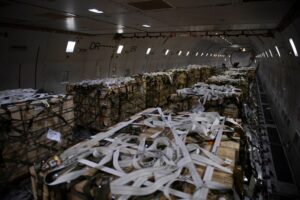President Biden on Thursday said the U.S. will send another $800 million in military equipment to Ukraine, to include new AEVEX Aerospace-built tactical drones recently developed by the Air Force.
The latest weapons package for Ukraine, the eighth such drawdown of U.S. equipment to support Ukraine in its ongoing fight against Russia’s invasion, includes more than 120 of the new Phoenix Ghost drones as well as 72 155mm howitzers and 144,000 artillery rounds and 72 tactical vehicles to tow the howitzers.

“Now, [Russia has] relaunched and refocused their campaign to seize new territory in eastern Ukraine. We’re in a critical window now of time where they’re going to set the stage for the next phase of this war. And the United States and our allies and partners are moving as fast as possible to continue to provide Ukraine the weapons they need and the equipment they need to defend their nation,” Biden said during remarks on Thursday.
Biden noted the White House is readying to send Congress a request for more supplemental funding to continue supporting the delivery of military equipment to Ukraine, adding the Pentagon is currently working through the final funding numbers that will be required.
“However, with this latest disbursement, I’ve almost exhausted the drawdown authority I have that Congress authorized for Ukraine in a bipartisan spending bill last month,” Biden said. “In order to sustain Ukraine for the duration of this fight, next week I’m going to be sending to Congress a supplemental budget request to keep weapons and ammunition flowing without interruption to the brave Ukrainian fighters and to continue to deliver economic assistance to the Ukrainian people.”
Pentagon spokesman John Kirby, in a statement following Biden’s remarks, said the latest package was specifically “tailored to meet critical Ukrainian needs for today’s fight as Russian forces launch a renewed offensive in eastern Ukraine,” to include providing the new Phoenix Ghost tactical drones.
“This is a drone that had been in development before the invasion, clearly. The Air Force was working this. In discussions with the Ukrainians, again, about their requirements, we believed that this particular system would very nicely suit their needs, particularly in eastern Ukraine,” Kirby told reporters during a briefing Thursday afternoon.
Both AEVEX and the Air Force declined to comment on Phoenix Ghost and referred questions to the Pentagon, with Kirby not offering specific details on the system outside of its potential role for use by Ukrainian forces.
“I’m just not going to get into great detail about the specifications here. I would just tell you that this unmanned aerial system is designed for tactical operations, in other words largely but not exclusively to attack targets. It, like almost all unmanned aerial systems of course, has optics, so it can also be used to give you a sight picture of what it’s seeing, of course. But its principal focus is attack,” Kirby said during his briefing.
AEVEX announced this past November it received two awards under GSA’s ASTRO contracting vehicle that would allow potential U.S. government customers use of its test and training range in New Mexico and rapid prototyping services “for design, engineering, and integration of sensors and special mission aircraft, manned and unmanned.”
“We are extremely excited to add this best-in-class contract vehicle to our portfolio as it will significantly improve our ability to support innovative R&D and data management efforts across aviation for our warfighters operating in all domains,” Brian Raduenz, CEO of AEVEX, said in a statement at the time.
On March 4, AEVEX was also one of 50 companies selected for a new Navy contracting vehicle that “provides support for new and emerging requirements, as well as growth across the Naval Air Warfare Center Aircraft Division Webster Out Lying Field services portfolio,” according to a Pentagon announcement at the time.
It is not confirmed whether either of those contract awards are associated with the company’s work with the Air Force developing the Phoenix Ghost tactical drone.
On the additional howitzers in the latest security assistance deal, Kirby noted along with the 18 155mm howitzers included in the most recent weapons support package announced last week that Ukraine will have enough artillery systems to equip five battalions (Defense Daily, April 13).
“It’s added firepower. Now, we’re not putting U.S. troops in with these systems. So [Ukraine] is going to have to provide the artillerymen, of course. But it’s added capability. It’s five more battalions [worth], which is quite a number,” Kirby said. “What makes it important is the kind of fighting that we expect in the Donbas because of the terrain, because it’s open, because it’s flat, because it’s not as urban. We can expect the Russians to rely on long-range fires, artillery in particular.”
With the latest weapons package, the U.S. has now committed more than $4 billion in security assistance to Ukraine over the last year, to include more than $3.4 billion since the beginning of the Russian invasion.